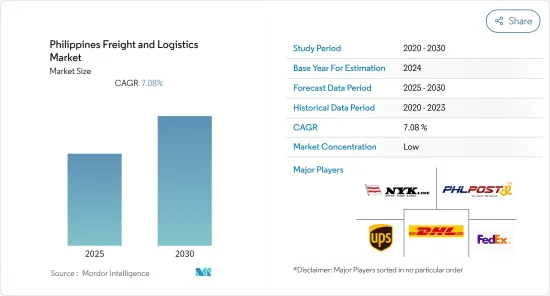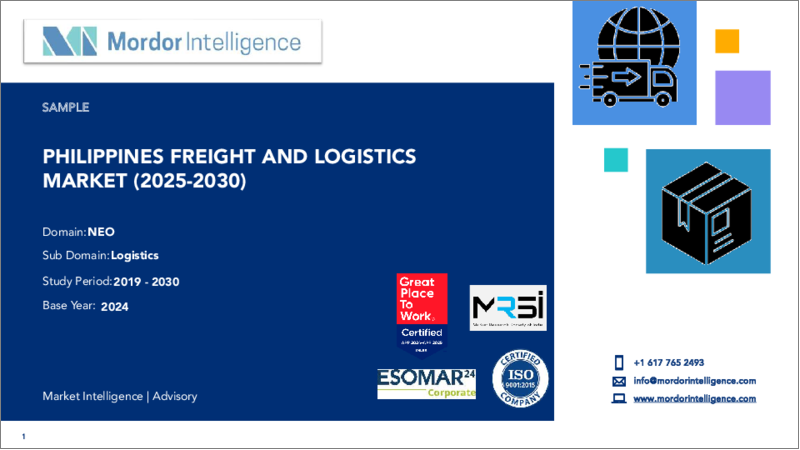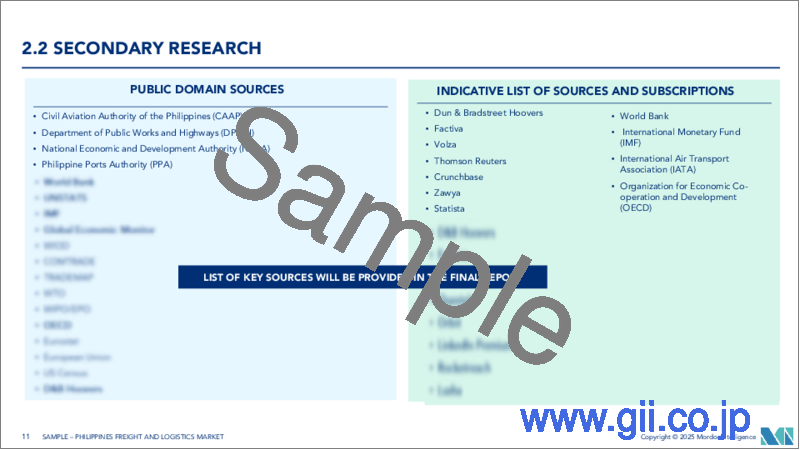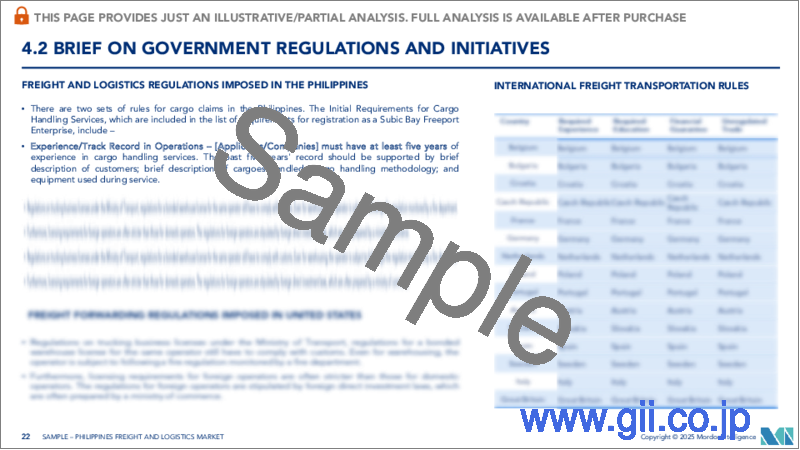|
|
市場調査レポート
商品コード
1687082
フィリピンの貨物・物流:市場シェア分析、産業動向、成長予測(2025年~2030年)Philippines Freight and Logistics - Market Share Analysis, Industry Trends & Statistics, Growth Forecasts (2025 - 2030) |
||||||
カスタマイズ可能
適宜更新あり
|
|||||||
| フィリピンの貨物・物流:市場シェア分析、産業動向、成長予測(2025年~2030年) |
|
出版日: 2025年03月18日
発行: Mordor Intelligence
ページ情報: 英文 150 Pages
納期: 2~3営業日
|
全表示
- 概要
- 目次
フィリピンの貨物・物流市場は予測期間中にCAGR 7.08%を記録する見込み

主要ハイライト
- パンデミック(世界的大流行)により、フィリピン国内のeコマースは増加しました。オンラインで購入する人が増え、国内のオンライン小売業者も増えているため、この傾向は今後も続くと考えられます。フィリピン貿易産業省(DTI)によると、2020年3月には1,700社、2021年1月には9万3,318社のオンライン販売業者がありました。
- 倉庫産業はeコマースビジネスの隆盛に牽引され、依然として高い需要があり、これは2022年の産業・物流不動産セクターの成長にとって良い兆しです。Colliers Philippinesの調査によると、製造業、物流、eコマースは2022年も成長を続けるといいます。Colliersによると、カビテ・ラグナ・バタンガス(CALABA)回廊の工業用空室率は、2020年の5.7%から2021年上半期には5.6%に減少しました。
- Colliersは、オンライン小売市場が拡大を続ける中、FMCG(Fast-Moving Consumer Goods)企業からの倉庫・保管スペースに対する需要が増加したことが減少の要因であるとしています。DTIのeコマース・ロードマップによると、eコマース部門は2022年までに約1兆2,000億PHP(250億米ドル)の貢献が見込まれています。Colliers Philippinesによると、今後12~36ヶ月の間に冷蔵倉庫のニーズが高まり、工業用資産の需要が高まると予想されています。投資委員会(BOI)は、2023年までにフィリピンのコールドチェーン部門が200億PHP(4億1,700万米ドル)の収入を生み出すと見込んでいます。
- デジタルシフトは、Lazada、Zalora、Shopeeのようなeコマース企業が主導しています。彼らは、Ninja VanやLalamoveのような技術主導型の物流企業と協力して商品を輸送し、顧客がリアルタイムで注文を追跡できるようにしています。デジタルに切り替えることで、注文状況の透明性が高まり、リードタイムが短縮され、通関プロセスが最大80%スピードアップし、わずか3~5営業日で済むようになります。
フィリピンの貨物・物流市場の動向
eコマースの成長がフィリピンの物流市場を牽引
Lazada Groupによると、フィリピンのeコマース市場は、同地域の競合他社よりも早い成長が見込まれています。Lazadaは、今後5年から10年の間に、フィリピンとその他の東南アジア諸国におけるeコマースは、世界の景気減速と物価上昇にもかかわらず、パンデミックから回復するため、「はるかに高い」成長を遂げると予想しています。
さらに2022年には、国境を越えたeコマース売上も成長率を目の当たりにし、米国農務省(USDA)の調査によると、フィリピンでは7,000万人以上のオンラインユーザーが国境を越えたeコマース(CBE)に参入し、主に非食品を購入し、eコマース売上市場の第4位の貢献度を占めています。国境を越えたeコマースの売上がかつてないほど伸びているのは、フィリピンの消費者がさまざまな輸入品を直接購入するようになったことが主要要因です。
加えて、輸入製品や飲食品に関するフィリピン人消費者の意識の高まりが、2019年のゼロから2022年には約100万米ドルの購入となり、CBE売上をさらに強化しました。また、越境eコマース販売の開発は、貨物輸送業者、倉庫、その他の付加価値サービスなどの需要をさらに促進します。一方、2022年には、電子商品がeコマースプラットフォームから大きな売上を示し、その売上は60億米ドル以上に達し、パーソナルケア、家庭用品、家具、ファッションなどが続きます。このように、eコマースの売上拡大は、国内の物流業者にとって大きなビジネス機会となります。
フィリピンの貨物・物流市場を促進するインフラへの支出増加
交通、エネルギー、WASHの慣例的なセグメントで、フィリピンは2022年の新規プロジェクトを発表しました。(水プロジェクト)を発表しました。市場シェアの大半は引き続き地元企業が占めているが、地元企業に必要な技術的専門知識がない場合、新規産業や新興産業(データセンターの官民パートナーシップ計画など)において、国際的企業との協力関係が形成されるケースもあります。
米国が資金を提供するフィリピン・コールドチェーンプロジェクト(PCCP)のような政府プログラムも、東南アジア諸国のコールドチェーン物流インフラの改善に役立っています。PCCPは米国農務省(USDA)の資金提供による4年間のプロジェクトです。改善された技術を提供し、コールドチェーン関連市場を拡大し、中間組織を強化することによって、生産者グループを組織化し、農業生産性を向上させ、国際的な食品安全基準を満たそうとしています。
フィリピンの官民パートナーシップによるケノン道路改修工事は、China First Highway Engineeringや日本のJFE Engineering Corporation of Japan(PPP)を含む入札希望者から関心表明を得ました。地元の建築会社であるFirst BalfourやRiofil Corporationも参加しました。フィリピン国家経済開発庁(NEDA)は、DPWHが最終承認を得るためにケノン道路プロジェクトを提出する場所です。この33kmの道路は拡幅され、18の橋が改良され、法面保護が必要です。
フィリピンの鉄道網は、数十年にわたる放置と過少支出によって老朽化した状態を放置した後、再生しつつあります。フィリピン政府の最優先課題のひとつは、マニラの南北通勤鉄道であり、これはフィリピン政府にとって過去最大のインフラ投資です。NSCRは、北部のクラーク市とニュークラーク市という地域の成長センターと、マニラ中心部、首都南部のラグナ州カランバ市を結ぶ163路線kmの郊外鉄道網として構想されています。
しかし、2022年1月現在、公共事業高速道路省によると、フィリピン政府の主要インフラプロジェクト119件のうち15件が完了しており、これにはパシグ川沿いの残りの区間の整備も含まれています。一方、77のプロジェクトが建設段階にあり、27のプロジェクトがパイプラインにあります。このように、フィリピン全土で増加している物流インフラプロジェクトは、貨物・物流事業を促進すると予想されます。
フィリピン貨物・物流産業概要
フィリピンの貨物・物流市場の競合は断片的で、国内外に多くのロジスティクスサービスプロバイダーが存在します。既存の大手企業には、FedEx、UPS、DHL、Kuehne+Nagel、PHL Post、Nippon Express、2GO Expressなどがあります。
国際的な参入企業は、新たな物流センターやスマート倉庫の開設など、地域の物流ネットワークを確立するための戦略的投資を行っています。eコマースの成長は、宅配便サービスの開発に拍車をかける不可欠な要因です。消費の増加とインターネットの普及が、フィリピンでのeコマース活動を後押ししています。
その他の特典
- エクセル形式の市場予測(ME)シート
- 3ヶ月間のアナリストサポート
目次
第1章 イントロダクション
- 調査の前提条件と市場定義
- 調査範囲
第2章 調査手法
- 分析手法
- 調査フェーズ
第3章 エグゼクティブサマリー
第4章 市場洞察と市場力学
- 現在の市場シナリオ
- 政府の規制とイニシアティブ
- 市場力学
- 促進要因
- eコマース売上の拡大
- 抑制要因
- 高い配送コスト
- 機会
- インフラプロジェクトへの投資の増加
- 促進要因
- 産業の魅力-ポーターのファイブフォース分析
- 供給企業の交渉力
- 消費者の交渉力
- 新規参入業者の脅威
- 代替品の脅威
- 競争企業間の敵対関係
- 産業バリューチェーン/サプライチェーン分析
- 技術動向へ洞察
- eコマース産業へ洞察
- フィリピンの物流インフラ開発に関する洞察
- フィリピンの宅配・エクスプレス小包(CEP)市場概要
- COVID-19が市場に与える影響
第5章 市場セグメンテーション
- 機能別
- 貨物輸送
- 道路
- 海上・内水面
- 航空輸送
- 鉄道
- 貨物輸送
- 倉庫業
- 付加価値サービスなど
- 貨物輸送
- エンドユーザー別
- 製造・自動車
- 石油・ガス、鉱業、採石業
- 農業・漁業・林業
- 建設業
- 流通・貿易
- 医療と医薬品
- その他
第6章 競合情勢
- 企業プロファイル
- Deutsche Post DHL Group
- FedEx Corporation
- United Parcel Service(UPS)
- Nippon Yusen NYK(Yusen Logistics)
- PHL Post
- Nippon Express
- LBC Express
- 2GO Express
- JRS Express
- DB Schenker
- Kuehne+Nagel International AG
- CJ Logistics*
- その他の企業
第7章 市場の将来
第8章 付録
- マクロ経済指標
- 資本フロー洞察
The Philippines Freight and Logistics Market is expected to register a CAGR of 7.08% during the forecast period.

Key Highlights
- The pandemic increased e-commerce in the nation as cautious consumers stayed home to avoid coming into contact with disease vectors. As more people purchase online and there are more online retailers in the country, this tendency will likely continue. According to the Philippines' Department of Trade and Industry (DTI), there were 1,700 online sellers in March 2020 and 93,318 in January 2021.
- The warehouse industry was still in high demand, driven by the thriving e-commerce business, and this bode well for the industrial and logistics real estate sector's growth in 2022. According to a survey by Colliers Philippines, manufacturing, logistics, and e-commerce will continue to grow in 2022. According to Colliers, the industrial vacancy rate in the Cavite-Laguna-Batangas (CALABA) corridor decreased to 5.6% in the first half of 2021 from 5.7% in 2020.
- Colliers attributed the reduction to the increase in the demand for warehouse and storage space from fast-moving consumer goods (FMCG) companies as the country's online retail market continues to expand. The e-commerce sector is anticipated to contribute around PHP 1.2 trillion (USD 25 billion) by 2022, according to the DTI's e-commerce roadmap. According to Colliers Philippines, the increased need for cold storage facilities is anticipated to support demand for industrial assets over the next 12 to 36 months. By 2023, the Board of Investments (BOI) expects the country's cold chain sector to generate PHP 20 billion (USD 417 million) in income.
- The digital shift has been led by e-commerce firms like Lazada, Zalora, and Shopee, who work with tech-driven logistics firms like Ninja Van and Lalamove to transport items so that customers can track their orders in real-time. Switching to digital will increase order status transparency, reduce lead times, and speed up customs clearance processes by up to 80%, taking only 3-5 business days.
Philippines Freight & Logistics Market Trends
Growth in e-Commerce to Drive the Logistics Market in Philippines
According to Lazada Group, the Philippine e-commerce market is expected to grow faster than its regional competitors. In the next five to ten years, Lazada expects e-commerce in the Philippines and the rest of Southeast Asia to grow "a lot higher" as these countries recover from the pandemic despite the global economic slowdown and rising prices.
Moreover, in 2022, cross-border e-commerce sales also witnessed a growth rate, and as per a United States Department of Agriculture (USDA) study, more than 70 million online users in the Philippines participated in cross-border e-commerce (CBE), mostly purchased non-food items accounting for the fourth largest contribution to the e-commerce sales market. The unprecedented growth in border e-commerce sales is majorly driven by Filipino consumers' shift towards acquiring a variety of imported goods directly.
In addition, the growing awareness among Filipino consumers regarding imported products and food and beverages further bolstered the CBE sales, from zero in 2019 to almost USD 1 million in purchases in 2022. Also, the developments in cross-border e-commerce sales further drive demand for freight forwarders, warehouses, other value-added services, etc. Meanwhile, in 2022, electronic goods witnessed significant sales from e-commerce platforms, and the sales amounted to more than USD 6 billion, followed by personal and household care, furniture, fashion, etc. Thus, the growing e-commerce sales create huge opportunities for logistics providers in the country.
Increased Spending on Infrastructure to Propel the Freight and Logistics Market in the Philippines
In the customary areas of transportation, energy, and WASH, the Philippines has announced new projects for 2022. (water projects). The local firms continue to hold the majority of the market share, but some collaborations with international players are being formed in new or emerging industries (such as a planned public-private partnership for a data center) when the local players lack the necessary technological expertise.
Government programs, such as the Philippines Cold Chain Project (PCCP), funded by the United States, are also helping to improve the Southeast nation's cold chain logistics infrastructure. The PCCP is a four-year project funded by the US Department of Agriculture (USDA). It is attempting to organize producer groups to increase agricultural productivity and meet international food safety standards by providing improved technologies, expanding cold chain-related markets, and strengthening intermediate organizations.
The Philippines' PHP 11 Bn (USD 214 Million) public-private partnership to rehabilitate Kennon Road has received expressions of interest from possible bidders, including China First Highway Engineering and JFE Engineering Corporation of Japan (PPP). Local building firms First Balfour and Riofil Corporation were among the others. The National Economic and Development Authority (NEDA) of the Philippines is where the DPWH will present the Kennon Road project for final approval. The 33km road has to be widened, 18 bridges need to be upgraded, and slope protection needs to be built.
The Philippines' railway network is undergoing a rebirth after decades of neglect and underspending that has left it in a decrepit state. Among the government's top priorities is the flagship North-South Commuter Railway in Manila, its largest-ever individual infrastructure investment. NSCR is envisaged as a 163 route-km suburban railway network connecting the regional growth centers of Clark and New Clark City in the north with central Manila and Calamba City in Laguna province to the south of the capital.
However, in January 2022, according to the Department of Public Works and Highways, 15 out of 119 flagship infrastructure projects of the Philippine government had been completed, which includes the improvement of remaining sections along the Pasig River. Meanwhile, 77 projects remain at the construction stage, while 27 are in the pipeline. Thus, the increasing logistics and infrastructure projects across the country are expected to fuel the freight and logistics operations.
Philippines Freight & Logistics Industry Overview
The competition in the Philippines freight and logistics market is fragmented, with the presence of many local and international logistics service providers. Some of the existing major players in the market include FedEx, UPS, DHL, Kuehne + Nagel, PHL Post, Nippon Express, and 2GO Express.
The international players are making strategic investments to establish a regional logistics network, such as opening new distribution centers, smart warehouses, etc. The growth of e-commerce is an essential factor spurring the development of courier services. Increasing consumption and Internet penetration are boosting e-commerce activity in the Philippines.
Additional Benefits:
- The market estimate (ME) sheet in Excel format
- 3 months of analyst support
TABLE OF CONTENTS
1 INTRODUCTION
- 1.1 Study Assumptions and Market Definition
- 1.2 Scope of the Study
2 RESEARCH METHODOLOGY
- 2.1 Analysis Methodology
- 2.2 Research Phases
3 EXECUTIVE SUMMARY
4 MARKET INSIGHTS AND MARKET DYNAMICS
- 4.1 Current Market Scenario
- 4.2 Brief on Government Regulations and Initiatives
- 4.3 Market Dynamics
- 4.3.1 Drivers
- 4.3.1.1 Growing E-commerce Sales
- 4.3.2 Restraints
- 4.3.2.1 High Shipping Costs
- 4.3.3 Opportunities
- 4.3.3.1 Increasing Investments in Infrastructure Projects
- 4.3.1 Drivers
- 4.4 Industry Attractiveness - Porter's Five Forces Analysis
- 4.4.1 Bargaining Power of Suppliers
- 4.4.2 Bargaining Power of Consumers
- 4.4.3 Threat of New Entrants
- 4.4.4 Threat of Substitutes
- 4.4.5 Intensity of Competitive Rivalry
- 4.5 Industry Value Chain/Supply Chain Analysis
- 4.6 Insights into Technological Trends
- 4.7 Insights into the E-commerce Industry
- 4.8 Insights into Logistics Infrastructure Development in the Philippines
- 4.9 Brief on the Courier, Express, and Parcel (CEP) market in Philippines (Market Size and Forecast)
- 4.10 Impact of COVID-19 on the Market
5 MARKET SEGMENTATION
- 5.1 By Function
- 5.1.1 Freight Transport
- 5.1.1.1 Road
- 5.1.1.2 Sea and Inland Water
- 5.1.1.3 Air
- 5.1.1.4 Rail
- 5.1.2 Freight Forwarding
- 5.1.3 Warehousing
- 5.1.4 Value-added Services and Others
- 5.1.1 Freight Transport
- 5.2 By End User
- 5.2.1 Manufacturing and Automotive
- 5.2.2 Oil and Gas, Mining, and Quarrying
- 5.2.3 Agriculture, Fishing, and Forestry
- 5.2.4 Construction
- 5.2.5 Distributive Trade
- 5.2.6 Healthcare and Pharmaceuticals
- 5.2.7 Other End Users
6 COMPETITIVE LANDSCAPE
- 6.1 Overview (Market Concentration and Major Players)
- 6.2 Company Profiles
- 6.2.1 Deutsche Post DHL Group
- 6.2.2 FedEx Corporation
- 6.2.3 United Parcel Service (UPS)
- 6.2.4 Nippon Yusen NYK (Yusen Logistics)
- 6.2.5 PHL Post
- 6.2.6 Nippon Express
- 6.2.7 LBC Express
- 6.2.8 2GO Express
- 6.2.9 JRS Express
- 6.2.10 DB Schenker
- 6.2.11 Kuehne + Nagel International AG
- 6.2.12 CJ Logistics*
- 6.3 Other Companies
7 FUTURE OF THE MARKET
8 APPENDIX
- 8.1 Macroeconomic Indicators
- 8.2 Insights into Capital Flows






